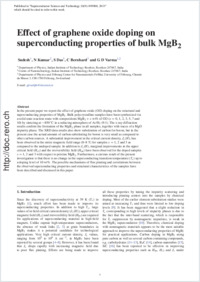Effect of graphene oxide doping on superconducting properties of bulk MgB2
- Sudesh, Sharma Department of Physics, Indian Institute of Technology Roorkee, India
- Kumar, N. Centre of Nanotechnology, Indian Institute of Technology Roorkee, India
- Das, Saikat Department of Physics and Fribourg Centre for Nanomaterials-FriMat, University of Fribourg, Switzerland
- Bernhard, Christian Department of Physics and Fribourg Centre for Nanomaterials-FriMat, University of Fribourg, Switzerland
- Varma, G. D. Department of Physics, Indian Institute of Technology Roorkee, India - Centre of Nanotechnology, Indian Institute of Technology Roorkee, India
-
01.09.2013
Published in:
- Superconductor Science and Technology. - 2013, vol. 26, no. 9, p. 095008
English
In the present paper we report the effect of graphene oxide (GO) doping on the structural and superconducting properties of MgB₂. Bulk polycrystalline samples have been synthesized via a solid state reaction route with compositions MgB₂ + x wt% of GO (x = 0, 1, 2, 3, 5, 7 and 10) by sintering at ~850 ° C in a reducing atmosphere of Ar/H₂ (9:1). The x-ray diffraction results confirm the formation of the MgB₂ phase in all samples, together with traces of a MgO impurity phase. The XRD data results also show substitution of carbon for boron, but in the present case the actual amount of carbon substituting for boron is very small as compared to other carbon sources. A substantial improvement in the critical current density, Jc(H), has been observed in the entire magnetic field range (0–8 T) for samples x = 1, 2 and 3 as compared to the undoped sample. In addition to Jc(H), marginal improvements in the upper critical field (Hc2) and the irreversibility field (Hirr) have been observed for the doped samples x = 1, 2 and 3 with respect to pristine MgB₂. Furthermore, a curious result of the present investigation is that there is no change in the superconducting transition temperature (Tc) up to a doping level of 10 wt%. The possible mechanisms of flux pinning and correlations between the observed superconducting properties and structural characteristics of the samples have been described and discussed in this paper.
- Faculty
- Faculté des sciences et de médecine
- Department
- Département de Physique
- Language
-
- English
- Classification
- Physics
- License
-
License undefined
- Identifiers
-
- RERO DOC 208624
- DOI 10.1088/0953-2048/26/9/095008
- Persistent URL
- https://folia.unifr.ch/unifr/documents/303255
Statistics
Document views: 150
File downloads:
- pdf: 442
